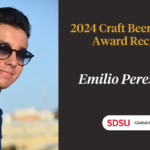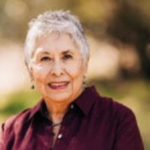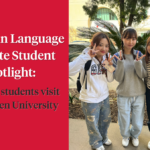
Cristina Alfaro, Ph.D.
Department Chair, Dual Language and English Learner Education
Dual language programs are flourishing in elementary schools across the country. Also known as two-way immersion, they give English language learners (ELLs) and English-proficient students instruction in English and a target language in the same classroom, starting in kindergarten for a minimum of six years. Students develop proficiency in both languages while learning from one another and supporting each other.
In San Diego, the primary target language is Spanish. Throughout the country, there are more than 20 target languages including Arabic, French, Hawaiian, Japanese, Korean, and Mandarin.
Dual language programs have become so popular and widespread that the Los Angeles Times refers to them as “the new face of bilingual education.” As such, the demand for educators to teach in these programs has skyrocketed.
SDSU is helping teachers fill this critical need by offering graduate certificate programs in both Dual Language for Academic Literacy and English Language Development (ELD) for Academic Literacy through its Department of Dual Language and English Learner Education. Each program consists of four classes, two semesters, and 12 graduate units that can be counted toward a master’s degree. And as of fall 2014, both programs are fully online to best accommodate the schedules of educators.
“This program emerged as a result of teachers and administrators requesting additional preparation for working with English learners in English-only settings as well as teachers teaching in dual-language programs in the Common Core era,” said department Chair Cristina Alfaro, Ph.D.
The Dual Language certificate program provides K-12 teachers and other education professionals with instruction in two languages and focuses on students developing competencies in bilingualism, biliteracy, and biculturalism/multiculturalism.
The English Language Development certificate program prepares educators for developing academic literacy assessment, curriculum, and teaching methods specifically designed to meet the needs of ELLs.
Educator David Niss has taught for 20 years in the Lemon Grove School District, which has had a dual-immersion curriculum for the last six years. He’s completing his certificate in English Language Development along with a master’s program.
“This program is giving me insight into bilingual education in California and throughout the country,” he said of the certificate program. “We have a high percentage of Latino students at our school. The SDSU program is motivating me to be the best for our Lemon Grove students who face language challenges and grow up in poverty.”
Niss is among two males in his cohort of 27 educators, most of whom are Hispanic.
“I haven’t lived through the struggles of being a bilingual child as most of my colleagues have,” he said. “I come from a little bit of an outside perspective. I am coming from more of a social-justice angle of bilingual education and am learning a lot from my colleagues.”
 Diana Cordero Sanchez, an elementary school teacher in the South Bay Union School District, is enrolled in the Dual Language program.
Diana Cordero Sanchez, an elementary school teacher in the South Bay Union School District, is enrolled in the Dual Language program.
“I can tell you that I have thrived in my teaching profession because of what the Project CORE program availed me to do,” she said. “It was like receiving the education of a master’s in the rigor. I loved everything about this program. I recommend it to teachers in general – not necessarily to bilingual teachers – but anyone that works with ELLs.”
Gisela Marable, who teaches in the National City School District (a K-6 district), also benefitted from the Dual Language for Academic Literacy program.
“It was such a fantastic, educational, and rigorous course that it gives me pleasure to say that I worked hard because that was the expectation of the professors and my own expectation,” she said.
For more information on the Dual Language and English Language Development Certificate programs, please visit neverstoplearning.net/duallanguage.
Elementary School Teacher Sees Social Justice Among Benefits of Dual Education
 Now in his 20th year at Mt. Vernon Elementary School in the Lemon Grove School District, David Niss teaches the English side of a 50-50 model dual immersion (Spanish/English) program. He’s currently halfway through his combination Master of Arts and English Language Development Certificate through SDSU’s Department of Dual Language and English Learner Education.
Now in his 20th year at Mt. Vernon Elementary School in the Lemon Grove School District, David Niss teaches the English side of a 50-50 model dual immersion (Spanish/English) program. He’s currently halfway through his combination Master of Arts and English Language Development Certificate through SDSU’s Department of Dual Language and English Learner Education.
Q: Give us a brief history of your education.
A: I got my BA in Journalism from SDSU in 1985, and my CLAD Multiple Subjects Teaching Credential from National University in 1995.
Q: What was your objective in taking SDSU’s English Language Development program?
A: My teaching partner, Irisbelle Rodriguez-Mosler is a program graduate and an awesome, inspirational teacher and advocate for kids. I want to contribute as much as possible to the success of our program, and the $7,000 in combined stipends was an incentive as well.
Q: How did the program meet your expectations?
A: I’m learning strategies and approaches to improve my teaching effectiveness along with the history, politics, and philosophical underpinnings of teaching bicultural and impoverished students, who are the majority of my clientele.
Q: What insights did you gain into bilingual education?
A: I wasn’t involved in the struggle to legitimize bilingual instruction, so the program has filled in gaps in my knowledge of the pitched battles that have been fought over the issue, particularly the impact of Proposition 227 here in California and how it ironically led to the expansion of dual-language programs across the state. [Passed in 1998, Proposition 227 required California public schools to teach LEP students nearly entirely in English. In most cases, it had the effect of eliminating bilingual classes.]
Q: How do educators who haven’t gone through the program deal with students for whom English is a second language?
A: That’s a tough one to answer since teaching is an art and teachers’ approaches vary widely. I know that my relatively privileged background has at times blinded me to some of the issues my students and their families deal with beyond learning English. Some teachers have trouble understanding why some students seem to lack motivation or why some families seem to de-emphasize academics. I think a lot of it depends on how open a teacher is to questioning his or her own assumptions about other people.
Q: What are some of the things the program availed you to do that you couldn’t do before?
A: I think generally just being able to relate better to the struggles our students face, both academically and socially. Kids grow up fast where I teach, yet they still hunger for discovery, guidance, and stability.
Q: How crucial was the program’s online aspect in fitting it into your schedule?
A: Most of my program consists of traditional class instruction augmented by partnership and group projects. Professors post resources online, and communicate with us via email or text, and most assignments are submitted online as well, but I’d hardly call it an online program. I probably spend a minimum of 8 hours weekly online for these courses, whether it’s reading, researching, or collaborating with others in my cohort. The twice-weekly afternoon or evening class meetings have allowed me to participate while continuing to teach full-time.
Q: What do you think are the program’s biggest strengths?
A: Emphasis on social justice. I grew up in a state of relative privilege (which I was largely unaware of until I reached adulthood). I naively assumed most of my pals and classmates would attend SDSU, which was the neighborhood college for me since I grew up just a couple miles away in Allied Gardens. But only a few did, and I never ran into any of the kids who were bused into my high school once I started attending State. Statistically, most of my students don’t get the opportunity to attend four-year universities. Yet they are every bit as bright, talented, and motivated as anyone (including adults). It’s not right that their opportunities are more limited than mine, and I want to work to change that. Teaching as a career choice was part of that, and my participation in Project CORE is its natural progression.
Q: What do you love best about teaching?
A: Having the honor and opportunity to work with children to bring about positive change in the world. I want to add that we’ve started the process of obtaining International Baccalaureate certification at my school. [Certified schools are known as IB World Schools and are authorized to teach special international programs that encourage personal and academic achievement.]
Q: Anything else you’d like to add?
A: Just that it’s invigorating for a relative geezer like me to be back on campus and engaging with fellow professionals who share their passion for teaching and learning.




